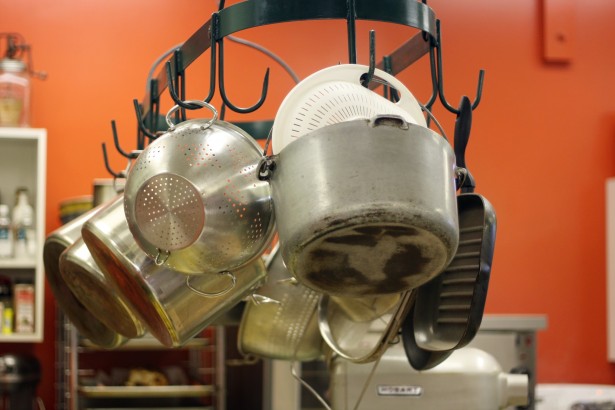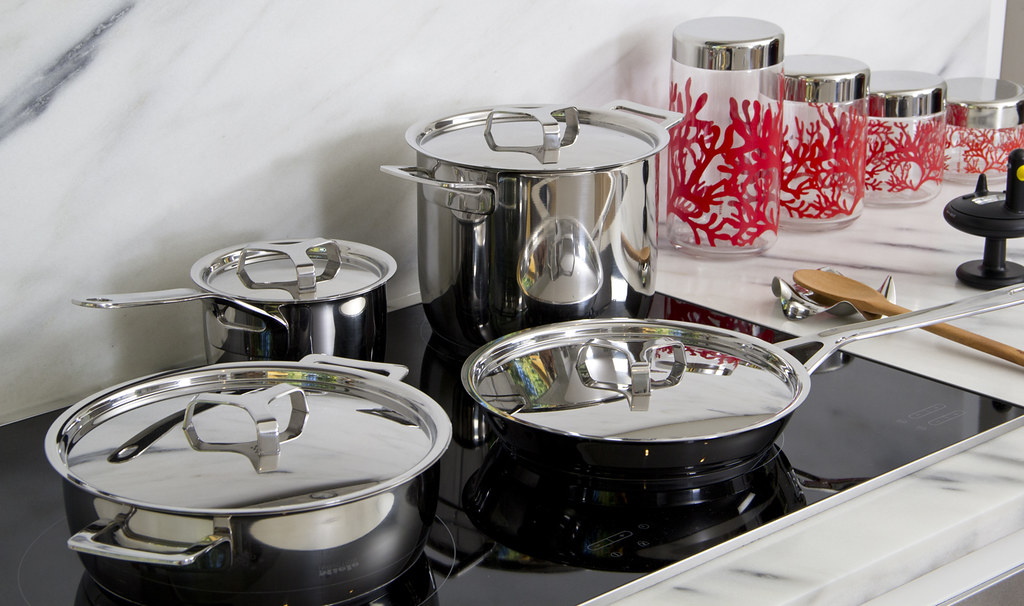Cleaning the bottom of pots and pans can be a challenging task, but it doesn’t have to be. With the right equipment and method, you can make sure your cookware is as clean as possible without any extra hassle.
In this guide, how to clean bottom of pots and pans, we’ll take you through all of the steps necessary for cleaning the bottom of your pots and pans, no matter how caked-on the food and grease may be.
From using natural ingredients to special tools that make the job easier, we’ve got all of the tips you need to get your cookware looking like new in no time!
So without further ado, let’s dive into our guide on how to clean the bottom of pots and pans.
Quick Navigation
How to Clean the Bottom of Pots and Pans?
Lime and salt combination:
If your pan is stainless steel, combine the power of lime and salt for an unbeatable cleaning solution.
First, pour some lime and salt on the pan – giving it time to sit up to two minutes so its chemistry can work its magic. Then add more salt before getting scrubbing right away. When you’re finished, rinse with clean water, revealing sparkling results in moments!
Use a non-abrasive scrubber:
To avoid scratching the finish of your pots and pans, use a non-abrasive scrubbing pad or brush when cleaning. This will help remove stubborn food and grease build-up without damaging the surface of your cookware.
Try an overnight soak:
For particularly tough stains, fill the pot or pan with warm soapy water and let it soak overnight. This will help loosen up any baked-on food and grease, making it easier to clean in the morning.
Use a heavy-duty cleaner:
For extremely stubborn stains, try using a heavy-duty cleaning product like an oven cleaner or a degreaser. Be sure to follow the directions on the product and use it in a well-ventilated area for the best results.
Add vinegar or baking soda:
Give your pans a new lease on life with the mild abrasive power of baking soda. Whether it’s stainless steel, cast-iron, or ceramic, even nonstick surfaces (just be careful not to get any baking soda onto those!).
You can make them look good as new again by mixing three parts baking soda and one part warm water into a paste then letting it rest for ten to twenty minutes before scrubbing off using something soft like an old toothbrush!
For extra cleaning punch, why not add some dish soap or white vinegar whilst scourering? See how great all your cookware looks after giving this simple method a go!
If you have cast iron or copper, try salt:
For cast iron and copper pans, try mixing equal parts salt and flour to create a thick paste. Rub the paste onto the bottom of your pan with a damp cloth or sponge and let it sit for 30 minutes before washing away.
Cream of Tartar
For a simple and effective way to clean your pots, mix three spoons of cream of tartar with one spoonful of water until it’s fully blended.
Let the mixture sit for around 10 minutes before scrubbing off with a wet sponge – just like you would when using ketchup! But be warned: this trick won’t work on cast iron or stainless steel pans.
If you are working with copper or stainless steel, use a mild acid:
Keep your ceramic, copper, or stainless steel pots and pans looking fresh with a simple trick! A mild acid such as lemon juice, white vinegar, or even tomato paste can work wonders on tough stains and grease spots.
Let the pan bottom soak in the solution for 10 minutes before giving it a scrub-down – you’ll be left with sparkling cookware that’s good as new!
If you have non-stick cookware, be careful:
When cleaning non-stick cookware, be sure to use a soft-bristled brush and gentle detergents. Avoid using abrasive scrubbing pads or steel wool on non-stick surfaces as this can damage the finish of your cookware.
Borax:
You don’t need to be a pro at cleaning for sparkling pans – just mix half-a-cup of borax with some warm water, give your pan a dip and let it soak up the solution.
After leaving it alone for a few minutes, rinse off all that grime away, you’ll have clean enough pots and pans to impress even Gordon Ramsey!
Dishwasher:
Cleaning is often made easy with modern technologies, but sometimes traditional methods still remain the best. When tackling difficult stains on cooking utensils, many people turn to their trusty dishwasher.
However, it’s important to be aware that this isn’t always an ideal solution. Cast iron and non-stick pans can easily become damaged in a standard washing machine cycle so should instead require manual scrubbing or steam cleaning for effective results; Teflon skillets are one of the few exceptions as they’re not vulnerable to similar damage risk from dishwashers.
COCA-COLA Drink
I know coca-cola is not good for health but this is also one of the most famous solutions to clean the bottom of pans.
First, pour some cola on the bottom of the pan and let it sit for 20 minutes until its chemistry works its magic.
Then scrub with a non-abrasive sponge or cloth and rinse with warm water. The carbonated bubbles help loosen up grease and food build-up, leaving your pans looking like new!
However, it is recommended that you only use coca cola for stainless steel and cast iron pans. Avoid using it on non-stick cookware as the citric acid in the drink can damage the finish of your cookware.
And there you have it – a few simple tricks to help bring your beloved pots and pans back to life! Whether you’re tackling a tough stain or deep cleaning your everyday cookware.
The cleaning agent:
if you are looking for the ultimate solution to remove pesky stains from your pots and pans, the bar keeper’s friend is here! This multi-purpose cleaning agent can be used on any cooking utensils made of aluminium, copper, stainless steel or cast iron.
It works wonders if you mix it with some water and leave it for 10 to 15 minutes before giving a light scrubbing with a sponge – no need for elbow grease!
Make use of commercial cleaners:
For particularly stubborn stains, there are also specialized commercial cleaners available on the market that can help tackle tough grime and grease buildup.
Need to get rid of that pesky burnt-on grease and grime on your pan bottoms? Look no further than commercial cleaning products with oxalic acid for a surefire solution!
Steel wool, oven cleaner, or other intense cleaners should be avoided; they might clean the gunk off but could also cause damage to your cooking utensils. Consult instructions when using these agents, it’ll have you all cleaned up in no time!
Be sure to follow the directions carefully when using these products and exercise caution when working with any chemical-based cleaner.
Follow up with a coat of oil:
After cleaning your pots and pans, make sure to finish with a coat of oil to protect the surface and help keep them looking their best.
This will help prevent rusting or corrosion, as well as give your cookware an extra layer of protection from wear and tear.
How to clean bottom of pan? Simple Steps
Step 1: Rough it up – Scrape off any caked-on food or grease using a wooden spoon, plastic spatula, or specialized scraper.
Step 2: Add salt and baking soda – Mix three parts baking soda with one part warm water to create a paste. Use this mixture to scrub the bottom of your pan with a soft cloth or sponge.
You can also mix salt and flour together to create a paste, which is especially useful for cast iron and copper pans.
Step 3: Soap it up – For tougher stains and grease spots, try adding some dish soap or white vinegar while scrubbing your pans.
Step 4: Letting it sit – Allow the paste or soap mixture to sit on the pan for 10-20 minutes before rinsing off with warm water.
Here are some tips for maintaining your pots and pans
1. Clean soon after cooking: Cleaning your pots and pans soon after use is the best way to keep them in top condition. Letting food and grease sit on the bottom of your cookware for too long can cause it to build up, making it harder to clean later.
2. Grease well before cooking: Greasing your pans before cooking helps keep food from sticking and also prevents it from burning on the bottom. Use cooking oil or butter to grease your pans before use, as this will help make them easier to clean after use.
3. Keep your stovetop clean: Over time, food and grease can build up on the surface of your stovetop, making it difficult to clean your pots and pans. Make sure to wipe down your stovetop regularly with a damp cloth or paper towel in order to keep it free of food and grease build up.
4. Dry thoroughly with a towel: After washing your pots and pans, make sure to dry them thoroughly with a clean towel. This will help prevent water spots and ensure that your cookware is completely dry before putting it away in the cupboard.
5. Store in a clean, dry place: In order to keep your pots and pans looking like new, make sure to store them in a clean, dry place when not in use. Make sure to keep them away from moisture and humidity, as this can damage the finish of your cookware.
6. Quality cookware can last for years if properly cared for, so investing in a good set of pots and pans is always a worthwhile investment.
Look for cookware made from durable materials like stainless steel or enameled cast iron, as these will be more resistant to wear and tear over time.
Conclusion:
Cleaning your pots and pans can seem like a daunting task, but with the right tools and techniques it doesn’t have to be! Whether you’re looking for commercial cleaning products or natural remedies, there are a variety of methods that will help get your cookware back in tip-top shape.
Remember to always use caution when working with any chemical-based cleaner, and remember to finish off your cookware with a coat of oil to help keep it looking its best. With these helpful tips, you’ll be able to keep your pots and pans clean and in pristine condition for years to come!
This guide about cleaning pots and pans should help you keep your cookware in good condition for a long time. Thanks for reading.


